by Daryl Roberts
A potentially paradigm-shifting technology has been under development at an R&D firm in NJ called Brilliant Light Power. For people monitoring the situation, the question currently is about the status of commercialization. It is not a publicly held firm, but is in mid-stages of private equity capitalization in the range of $100-120M.
I recently read a book titled “Randall Mills and the Search for Hydrino Energy“, offering a detailed and compelling history of the development of this novel renewable energy technology, authored by an insider, an intern who stayed on to work there for several years (published in 2016, with company data as of end of 2015). In order to provide some context, this article will summarize the concept, breakthrough achievements, compare its levelized costs to other generation technologies, offer a brief review of validation efforts, and touch on personnel and capitalization. I will try to be faithful to information presented in the book and website materials, and will try identify my own cautious opinions in context.
Concept
The technology was developed by Randall Mills, whose special talents manifested while still a graduate student in physics at Harvard, when he made a discovery in 1989 while exploring a foundational question in physics about why an orbiting electron did not radiate away its energy. Quantum mechanics diverged from classical mechanics without ever answering this question. Mills emerged with a revised classical theory that included the proposition that hydrogen’s ground state can in fact be lower than previously thought, that it can have fractional ground states.
According to Mills’ theory, hydrogen can react with a catalyst in a 2-step process, in which first a small amount of energy is transferred by a process called resonant inductive coupling, in integer increments of 27.2 eV. When this photon is accepted by the catalyst from the atomic hydrogen, the hydrogen electron then becomes unstable and will decay into a lower, fractional orbital, closer to the nucleus. This 2nd step releases a larger increment of energy than would be predicted by any other known chemical reactions, 200x higher than burning hydrogen. The ending species of hydrogen was dubbed a “hydrino”.
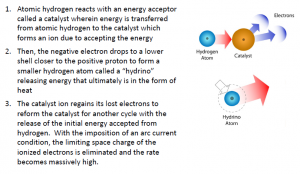
Validation
Mills documents extensive experimental confirmation, which to date has identified hydrino states of 1/2, 1/3, 1/4, down to 1/10 (orbital shell distance below 1.0 ground state). The theory calculates possible hydrinos with a theoretical limit of 1/137, constrained by relativistic speeds for the electron travel.
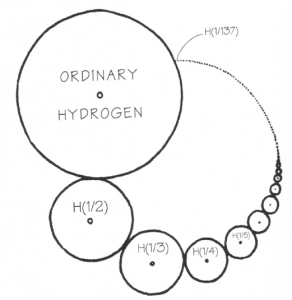
The book documents Mills’ 25-year journey of verification, both with collaborators and validation by a growing number of independent investigators who report finding confirmation in a wide range of experimental configurations. Mills was prolific in publishing his findings in the face of persistent resistance from establishment figures, in progressively more prestigious journals. The reference section of the book documents 96 journal articles with Mills as primary author(as of late 2015, now over 100), 52 journal articles with non-BLP primary authors, and 31 other technical reports regarding hydrino research by various universities, national labs and corporations.
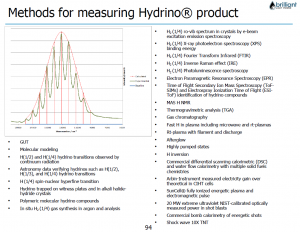
Early lab set ups involved low temperature electrolytic cells, but Mills eventually found that the phenomenon could be triggered and measured more successfully in high temperature plasma conditions. Subsequently, tests were constructed using various types of instrumentation, & validated by leading experimentalists in this field, experts in thermal measurement. A summary of the full extent of the verification data discussed in the book and website materials is beyond the scope of this article. But it’s worth including one slide which shows a list of 29 types of confirming evidence that has been compiled to date, including 7 or 8 types of spectroscopy and 4 or 5 types of calorimetry.
On the website, most of the Validation Reports are compiled under the technology tab and also under the News/ What’s New tab. The focus seems to be weighted most heavily on confirming that the energy is generated by the hydrino reaction process. Business presentations pdf’s, PowerPoints & videos of conference are in the News / Archive tab. The validation page reports 4 independent studies in 2020, 3 in 2019, 5 in 2016, and an additional 17 earlier reports.
Energy Gain
The specific excess heat generated is not documented uniformly within a single reference system. As I searched to compile these results, I found various expressions of “gain” cited in PowerPoint slides reporting outcomes from a range of experiments, as follows:
- “energy gain of 200-500x”
- “Optical energy output of 30x input”
- In a table identifying specific experiments showing a gain column, with 3 cases with highest values showing 399x, 279x & 213x
- “peak power 20MW, time-avg power 4.6MW, optical emission energy 250x applied energy”
- “input power 6.68 kW, output 1,260 kW” 1260/6.68 = 188x
- in terms of power density, as “20MW in microliters”, and elsewhere “billions of watts per liter”
- the 2020 validation studies report finding that hydrino plasma produced excess power of 275kW, 340kW, 200kW & 300kW respectively.
- 2019 report power levels of 1000kW & 100kW.
- 2016 studies report 514kW of optical power & 1.3MW peak power; 689kW with 28x gain; thermal power levels of 440kW; & 1.5MW continuous power from 8.6kW input (1500/8.6 = 174x)
It would benefit the company to clarify and reconcile these value, especially when differing by orders of magnitude, ie., in ranges of 10x vs 100x. This would help to make clear the specific the relationship between these output values and the resulting dramatic reductions in cost of energy production per kW, which are discussed further below.
SunCell
The experimental configurations evolved from demonstrating the effect in single shot events, to systems that could sustain continuous reactions and maintain a stable plasma. These early events in which a target material was bombarded by a catalyst along with a high current, low voltage electrical discharge to create the plasma conditions, resulted in an excess of energy so hot that even electrodes made of tungsten were vaporized.
The next steps involved engineering design to develop a commercial prototype, and optimization of supporting systems. The most challenging practical problem was designing an electrode that could withstand the high temperatures. This was solved by making the electrode entirely liquid, an arcing molten metallic silver electrode with a continuous feed, into which the catalyst was mixed, which enabled a continuous plasma reaction. The reaction took place in a small containment vessel, with the two feeder systems, one for the liquid silver, the other for moving the atomic oxygen and hydrogen in and hydrinos out. The plasma is maintained at 4000C and generated very high energy photonic radiation in the Extreme Ultra Violet frequency range (EUV), producing excess heat and molecular signatures confirming Hydrino profiles. Supporting systems were engineered for hydrolysis of the water, for induction pumping the silver, for heat transfer systems, and for electrical offtake.
The system was branded the “SunCell”.
The reaction produces no emissions other than the reduced hydrinos, which are 64x smaller volume than ordinary hydrogen. Current design captures the hydrino gas in a charcoal trap or a milled halide hydroxide crystalline matrix to which the hydrinos can bind. If exhausted into the air, it is inert, non-toxic, lighter than helium and would rise to the upper atmosphere.
The power from the plasma can be utilized either directly as heat with heat exchangers or can be converted to electricity by means of two distinct offtake technology configurations, that were developed and patented:
- Concentrating Photovoltaics (CPV) – the EUV can be converted by stepping down the frequency to the visible spectrum by means of “blackbody radiation”. The containment shell is made of refractory materials to optimize this conversion to optical energy which can then be captured with concentrating photovoltaic cells arrayed around the blackbody. The containment sphere is in essence like the filament of a light bulb, capturing multiple suns 24 hours a day, without intermittency.
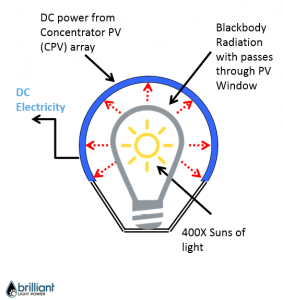
- MagnetoHydroDynamic (MHD) – the plasma heats an expanding gas seeded with conducting silver nanoparticles is passed through a transverse magnetic field, converting kinetic energy to electricity.
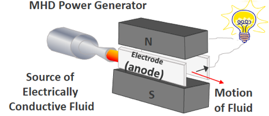
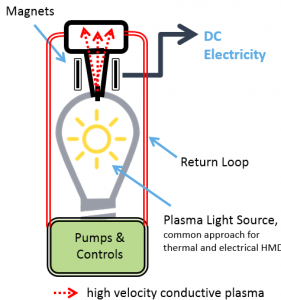
The more detailed engineering diagram of the SunCell PV design gives a better sense of the relatively compact scale of the device, in this instance only about 3ft high from the base platform.
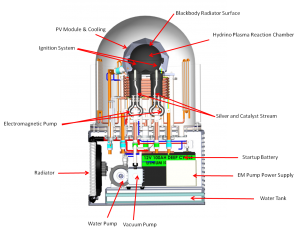
The device has very high power densities, can produce continuous power at 20MW/ liter. Below is a working demonstrator prototype in 2016.
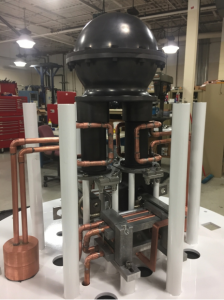 To illustrate the comparative power density of the SunCell compared to other stationary concentrating solar applications, they show this slide:
To illustrate the comparative power density of the SunCell compared to other stationary concentrating solar applications, they show this slide: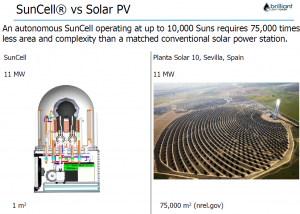 Costs
Costs
Costs are low because the capital costs to construct the devices are low, one estimate was $60/kW, which is less than 2% of capital costs for solar. Other operating costs are negligible, for maintenance & fuel, because other than the hydrogen fuel, which is derived from water, all the other materials, recycle within the device, and with few if any moving parts, and so can be expected to have life cycles of 20 years or more. The resulting energy costs are estimated at $.01/kWh, substantially lower than any other source.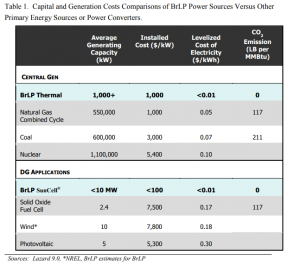 In business presentations from 2016, BLP made an attempt to provide more conservative comparisons using the Levelized Cost of Energy tables provided annually from asset manager Lazard considered to be the most reliable & comprehensive surveys are available. Using the most recent report published 11/7/19, BKP places their LCOE in this context, projecting costs at approximately 50% below the cost of solar & 30% less than Gas Combined Cycle.
In business presentations from 2016, BLP made an attempt to provide more conservative comparisons using the Levelized Cost of Energy tables provided annually from asset manager Lazard considered to be the most reliable & comprehensive surveys are available. Using the most recent report published 11/7/19, BKP places their LCOE in this context, projecting costs at approximately 50% below the cost of solar & 30% less than Gas Combined Cycle. 
With such low operating & capital costs, the revenue model is based on a flat per diem energy lease transaction rather than a metered price per kWh. Revenue is modeled based on a “breakthrough rate” below $.05/kWh, which is an arbitrary price sufficiently below market prices of competing sources, but with an enormous built in margin. Most of the pricing would be based on off-grid provisioning, rather than through the wholesale market auctions through ISOs and other grid operators. Hence, the capex & operating costs would represent approximately only 2-5%, with net earnings above 90%.
Costs will improve at scale, as the largest costs are for the CPV components. At production rates of 10GW annually, the estimated costs of the CPV cells are $32 per kW at concentration of 2000 Suns. A cost analysis for parts for a production model of the 2000 suns version show the PV cell assembly constitutes 60%, or $15,000 out of the total of $25,000. But at higher temperature plasmas, at 10,000 Suns concentration, optimizing output efficiencies, CPV costs drop to less than $6 per kW, or $2800, down to 23%.
Status of Commercialization
If the experimental validation data is accepted, and the resulting production cost calculations are supportable, the pressing question is: what is the status of commercialization? Why are we not seeing some of these devices appearing in the market yet? What is holding up the show? The book doesn’t get into this issue, although the author has communicated his intent to update with a 2nd edition that explains how this next phase has evolved since 2016.
The website unfortunately does not provide an easily accessible section featuring a sequential history of the commercialization status, either in a front page or a top line item in a dropdown menu, or a side bar or a featured story. However, digging deeper, comparing earlier & later website materials, the narrative can be reconstructed. The two main sources are Business Plan pdfs, & Demonstration Days, found under different tabs.
Business Plan pdf’s:
Earlier commercialization plans indicate the first target market will be industrial thermal energy users. The SunCell operates 3x more efficiently & 2.5x lower costs if the end product is process heat only, and the electric conversion phase of the system is not included. BLP envisioned the rollout timeline as shown below, as of 6/14/19. 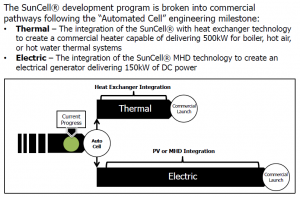 In Phase 1, after industrial users, commercial & residential thermal users are targeted next. Heat for high GHG generators, steel & concrete are targeted later presumably because those industries are more resistant to change.
In Phase 1, after industrial users, commercial & residential thermal users are targeted next. Heat for high GHG generators, steel & concrete are targeted later presumably because those industries are more resistant to change.
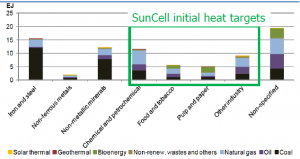 Phase 2 targets electricity markets, initially with the SunCell Photovoltaic design scaled to 10kW – 150kW. The next target would be scaled to 250kW – 2MW, to address Distributed Energy Resources (DERs) for industrial, commercial and multi-tenant residential buildings, providing micro-grid power that can be “islanded” from grid connection, simplifying system designs to eliminate the need for battery storage systems, and eliminating the utility connection costs & queueing time delays. SunCells can operate continuously, but can also be taken off line without curtailment or the need to redirect current to storage. They can be simply shutting down with smart controls to smooth peaking and manage very short ramping & re-start times. Multiple SunCells can be networked with low voltage private grid interconnections, minimizing the need to even interface with the public grid, reducing complications associated with utility permitting. Further, the potential for micro-grid configurations in rural applications could offer solutions to the wildfire risks in California.
Phase 2 targets electricity markets, initially with the SunCell Photovoltaic design scaled to 10kW – 150kW. The next target would be scaled to 250kW – 2MW, to address Distributed Energy Resources (DERs) for industrial, commercial and multi-tenant residential buildings, providing micro-grid power that can be “islanded” from grid connection, simplifying system designs to eliminate the need for battery storage systems, and eliminating the utility connection costs & queueing time delays. SunCells can operate continuously, but can also be taken off line without curtailment or the need to redirect current to storage. They can be simply shutting down with smart controls to smooth peaking and manage very short ramping & re-start times. Multiple SunCells can be networked with low voltage private grid interconnections, minimizing the need to even interface with the public grid, reducing complications associated with utility permitting. Further, the potential for micro-grid configurations in rural applications could offer solutions to the wildfire risks in California.
Phase 3 addresses transportation applications in a subsequent phase, for trains, large-scale marine (transport ships that currently burn high emission bunker oil), buses & trucks, and ultimately passenger vehicles and electric aviation. The MHD version can be scaled down for light vehicles to a size much smaller than either internal combustion engines or EV batteries.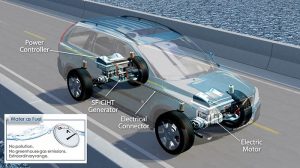
Demonstration Days, found under the News/Archive tab, includes 6 videos of roadshow presentations, with slides, from 1/28/14 – 10/26/16, and 4 additional presentations actually called “Roadshows” (although it is not clear that any of the roadshows are intended to be investor pitches).
Information most relevant to the status of commercialization were a) presentations by two contracted engineering firms, and b) reference in one of the last Demo Day pdfs to a new set of contractors.
- Columbia Tech which is a mid-sized management firm in Boston, not a GE or Siemens, but does $200M/yr revenues, has 500 employees, was selected by BLP to manage transitional processes moving from the development engineering being done at BLP to the production engineering which may be further farmed out. They presented slides indicating where it thinks BLP is in the process.
This is a nice schematic infographic, but there was little in the content of the presenter’s material that disclosed that CT had actually started doing any work, or that there was an expected date for BLP to begin handing off tasks for CT to execute on its path to production development. Later in that same Demo Day, the in-house marketing director showed his own similar schematic, which added some detail but no new information about actual developments.
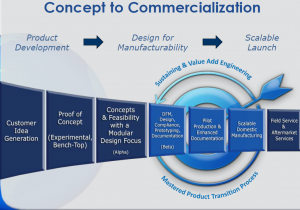
- Masimo (formerly Spire, a PV manufacturer) contracted to develop a custom CPV system. However, Masimo also has disappeared, no further reference to either progress on their assigned contract, or that they are even still an industrial partner. Instead, in some later pdf slides, there is indication in some indication that BLP has reconsidered using non-concentrating PV, that they have been making a closer cost benefit analysis.
In the last roadshow pdf 9/12/17, slides #42 – #47 indicated new progress:
- TMI Climate Solutions (subsidiary of MiTek, a Berkshire-Hathaway company) appears to have been engaged to develop designs for boilers to offtake heat for thermal applications;
- Re Columbia Tech, they announce: “SunCell Commercialization engineering is mature enough to be outsourced to CT. Equipment is being fabricated, procured, shipped”. It seems to be associated with updated injector design solutions. Despite this promising indication, there was no further updates about CT after this report.
- PV development progress: indicates changes in design parameters, & perhaps a change from Masimo to SpectroLab (a Boeing company) to complete the development of the triple junction concentrator cells.
6/14/19 is the most recent update in a Business Presentation pdf. However, the material merely refined prior messaging, with some updates of prototyping and engineering solutions of SunCell system components, some new validation experiments conducted by independent scientists, and another review of 17 out of the 29 methods for verification of the Hydrino explanation. However, there were no further updates from ColumbiaTech, Spectrolab or Masimo, TMI Climate Solutions, or any other development partner about component status or overall system fabrication design status.
Advisory Board: Most have relevant experience in renewable energy development, seem to be well chosen to facilitate the development goals, and some have very high level backgrounds, such as James Woolsey, former Director of the CIA. This is at least a hopeful indicator that people with both management talent and influence consider the technology to have potential, & whose presence would tend to exert pressure for development progress.
$100 -120m of investment capital is mentioned in scattered references, all of which is from private equity offerings, but investors are NOT disclosed anywhere in the website. In another reference, there was an indication that some of the other investors were utilities, including a rural electric coop in NM, which may have participated by placing pre-orders rather than taking equity.
The Wikipedia page, which is very one-sided & antagonistic, states: “…Investors include PacifiCorp, Conectiv, retired executives from Morgan Stanley[12] and several former BLP board members:
- Shelby Brewer who was the top nuclear official for the Reagan Administration and CEO of ABB-Combustion Engineering Nuclear Power[17][18] ,
- Michael H. Jordan(1936 – 2010), CEO of PepsiCo , Westinghouse Electric Corporation, CBS Corporation and Electronic Data Systems.[17]”.
Conclusion
With so much potential for triggering transformation with a technology that leaps forward in efficiency & costs and significantly reduces GHG emissions both in fabrication and operation, one can only hope that Brilliant Light Power will be able to accelerate their commercial development process, and upgrade their website to be able to make updates more transparent and accessible.









This is an excellent and much appreciated overview of extremely important new science and technology. Fractional Hydrogen turns water into an extremely powerful fuel. This was first suggested by the late Dr. Robert Carroll in 1974. One of his students, the late Ronald Bourgoin, published a paper: Inverse Quantum States of the Hydrogen Atom – available on the web. It confirms what Randell Mills has achieved.
Brilliant Light Power seems poised to enter and disrupt markets that have resisted radical advances. It is not unusual for new science to take 30 years to yield practical products. BLP has had to overcome a huge number of attacks by skeptics and trolls. Their ability to raise $100m or more has been a remarkable achievement, unmatched by other firms developing what may prove to be equally significant renewable energy systems.
Thanks for your comments Mark.
I *LUV* Science Fiction! But I’m not clear why a SciFi plot device is being reported in an investment journal?
To broaden your perspectives, of course. Read through the 150 journal articles to confirm for yourself whether its merely science fiction.
I can see why it’s being reported in an investment journal. A few “SciFi” investments to name a few. Think about it!
AI Assistants, e.g. Siri
Tablet computers
Video calling, e.g., Skype, Amazon’s Echo Show, FaceTime
Communicator watces, e.g. Apple watch
Driverless cars
I have had the same frustrating experience in trying to understand the status of the project! My conclusion is that Mills is hiding some deficiency in the functionality that makes the system non-viable at this stage of development otherwise the world would be trampling over each other to produce them!
That seems the most likely explanation. My sense now is that there has been a shift in focus, away from the SunCell that uses the concentrating photovoltaic cells, & more effort to advance the MHD version.
Mills sent me a link to an article about the MHD engineering, published recently, 8/9/19 https://brilliantlightpower.com/pdf/MHD_Paper.pdf There were some indications that he was configuring the PV version with non-concentrating PV cells, lower efficiency but lower cost as well. There were several slides that state “engineering has been solved”, which in context were about various materials problems, about the electrodes, then about the containment vessel materials that had some degradation issues, I think another instance having to do with something related to tweaks necessary to achieving continuous plasma reactions. I spoke also with Holverstott, whose impression about the contract production engineering firm in Boston, was that they weren’t actually performing, not adding value to solving the transitional problems, leaving Mills back doing the bulk of the work, so they trimmed that relationship. I wonder about how widely industrial partners & renewable-focused private equity is monitoring the situation. There was one utility, Pacificorp, that has made commitments. According to their rollout plan, process heat is the 1st market, so they don’t need either the PV or the MHD, just off the shelf heat exchanger tech to be able to address that market, for which there were new consulting/design engineering firms mentioned in the most recent pdfs. Its difficult to really diagnose from the outside, most of the presentations put a positive spin on the situation, but you may be right, that there are problems about which there is insufficient transparency. Not uncommon with private development firms.
What’s more likely?
1. A 30 year quest by a misunderstood genius that will redefine modern physics.
2. An elaborate fraud.
As each year goes by, option 2 seems more likely. And don’t forget that BLP was Mills second effort. His first discovery was trying for a cancer cure with Mossbauer radiation, and his validation paper was later shown to be in error. BLP looks like the same thing on a larger scale.
You could be correct, although to paint the story in naked binary seems simplistic, assumes he’s not attempting to solve problems in good faith. My impression is that he’s following the investigative thread where it leads, its convincing in the numerous validation studies, & some investors have found it credible who have their own abilities to evaluate in due diligence, not likely rubes. And really, the classical solutions he has developed have been the basis on which the experimental have proceeded, so both theory & commercialization are one piece.
I think if you spoke to some of his earlier investors, the story would not be so rosy. For a start, you completely skipped over their earlier extensive promises of commercialization in 1997 and 2009.
Here’s the 1997 report to shareholders.
“The Company is in active discussions and negotiations as of the date of this Newsletter with corporations in all five categories. The Company anticipates that successful test results from its prototype, UV spectroscopy, and patent issuance all projected for first quarter 1998 will permit the Company to establish joint ventures and/or licensing agreements for the commercial use of the hydrogen gas energy cells.”
https://web.archive.org/web/19980212141859/http://blacklightpower.com:80/sharenews2.html
Here’s the 2009 utility partnership with commercialization only months away:
https://venturebeat.com/2009/07/30/blacklight-power-signs-sixth-utility-deal-to-produce-power-from-water/
Here’s another question. Who is Blacklight Real Estate, owner of the BLP office in New Jersey since 1998? It’s not typical for early stage companies to own real estate. And how is BLP doing all that intensive research when their office is only 500 sq ft, and the rest of the office is for lease, as listed here:
https://www.loopnet.com/Listing/493-Old-Trenton-Rd-East-Windsor-NJ/16461958/
Thank you for those links, I had not seen them yet. I had seen Connectiv & Pacificorp as named investors or licensees, which I mentioned in the article, as listed in wikipedia. I assume these two utilities (& the other 3 which I have not yet seen identified)) have had to write off their investments at this point. The real estate listing is puzzling, it shows as a 55,000 sq ft building complex, with “tenant” BLP occupying only 500 sq ft. Makes no sense. The more recent photos give the impression that BLP occupies a much larger part of the total, if not all of it. I don’t see anything in that listing that shows the owner to be “Blacklight Real Estate”. Do you have links to more recent Shareholder reports?
If you look up the BLP address in the NJ property parcel viewer, you can see it’s owned by an entity called Blacklight Real Estate Inc, c/o R Mills. Skeptics have been asking questions about this for years, since paying yourself rent would be a way to siphon investor money into your own pocket. Either way, it’s an extremely unusual arrangement for any venture funded company to own real estate or lease it from a related party.
The office space disparity certainly calls a lot of the BLP story into question. I recall Andrea Rossi had the same problem in Florida. You should call the brokers and ask for a Facetime tour. Maybe Mills is just ready to cash out after thirty years. I am sure Bernie Madoff got tired at some point too.
The negative comments are mostly based on assuming the incumbent physics, at times known as Standard Quantum Mechanics, as inviolable, or written as if in stone. There is too much history, careers, money and the like, supporting SQM, to allow a seemingly far fetched intruder to overturn so much, SQM, in such a short space of time by just one person. It is assumed such radical progress is to be achieved only under the acceptance of highly respected journals, over many decades. That still does not address the many egos that would be knocked down, if Mills way of doing physics were to be entertained even for a moment.
It is still much more than just about a nice way of producing cheap power or a nice business model. It is the ones in physics who have to be shown all this, as being somehow believable. Academic physics is very conservative minded, which also carries with it a lofty power base.
Commercialization sooner than you think. Already field testing a fully functioning 250 Kw thermal SunCell unit. Set to deliver to first clients for further field tests.
Except the field tests weren’t in the field. They were in a BLP lab where no one can verify them. No record of any actual client delivery.
Hi Dan,
Thanks for this update on BLP.
In my own small way I’ve been promoting BLP for years. Here’s a link to my fictional account where the Sun Bottle has an important role.
https://www.wattpad.com/387304120-and-we-will-have-snow-acknowledgementand
Thanks Jim, I appreciate your post. I’ve always been fascinated by energy and its many forms and facets. I believe Mills and BLP are on the verge of something profound as they enter this new phase of commercialization and distribution. This might just spark the “new energy” revolution that world has been talking about for years, but never really happened. I think a lot of people are going to be dumbfounded when they start to figure out what’s really going on.
Hi Dan,
I am writing this from the distant future. Sorry to say that quantum mechanics still works, Mills has still produced nothing, and [terribly sorry again] hydrino being in contradiction with modern quantum mechanics doesn’t exist.
Ha!
Either does dark matter… and yes Mills claims that the Hydrino is dark matter, so there
I am writing this from now. Sorry to say that ptolemy’s epicyclic model of the solar system still works, Copernicus, Galileo and Newton produced nothing and [sorry to say again] gravity being in contradiction with Aristotle’s philosophy doesn’t exist.
My Dad is a scientist, not a businessman, similar to Randall Mills! East Coast builds things slowly to get profit and continue the growth! West Coast, throws tons of money at something to be first to market and steal the entire market! By the time Randall gets his invention out the door, his patents will have expired and he’ll miss out on the rewards! Sad, he should have worked with someone like Elon Musk and could have got this on the market 10 years ago and changed the world and become the richest man in history! But I think Randall has too much ego and wants it all for himself! To be rich, you’ve got to share the pot with others who want to be rich too and have the skill you don’t have! Ship the damn project and let Randall Mills be Chief Scientist and work on what he loves to do! Let businessmen turn his ideas into big business Ventures! Plenty of scienties have reproduced his work, so I fully believe he has discovered and done the engineering work to bring this major discovery to market! No Get out of the way and let the business people and product development people build/distribute/sell!!!
I’ve followed Randall Mills for at least 15 years! I was talking with my dad about Thorium, who pointed this out to me! He had been following for 10 years earlier! The progress has been painfully slow!!! I was there before his single-shot reaction, like a cap-gun. Hence my comment above about getting some Silicon Valley Tech oligarch on board to develop/ship this! A team of 15 people just isn’t enough brainpower! and a very limited budget just isn’t enough to push this along! 100 Million dollars is NOTHING to Google/Apple/Tesla/Musk! Google would consider this a Moon-Shot, which they are desperately looking for! I would prefer Mills works with someone like Elon Musk and his Tesla Cars etc, much better fit although I don’t see the machine fitting in a car anytime soon, however it could be the source of recharging stations worldwide! Randall, let’s make it happen, the world needs this energy source! It would bring Peace to much of the earth! Everybody needs, Food, Water/Air, and Energy! This would solve the world’s energy problems, which would also solve the world’s food problems and make it significantly easier to desalinate water to solve the world’s water problems! Work with others to get it done!!! Your patents are closing out!